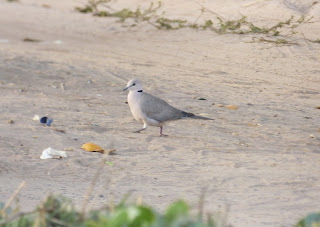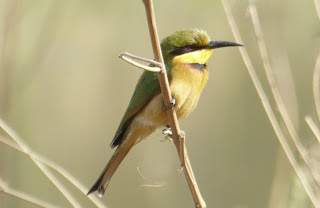The main man of Gambian birding Mallick Suso
Greater Painted Snipe
Casino Cycle Track at dawn
Pied Kingfisher
Wood Sandpiper
Grey-headed Gulls
Little Bee-eater
Vinaceous Dove
Superb habitat
White-faced Whistling Duck
Pearl-Spotted Owlet
Buffalo Weaver
Blue-bellied Roller
Green Wood Hoopoe
Western Reef Heron
Wire-tailed Swallow
Pied Kingfisher
Long-tailed Cormorant
Common Wattle-eye
Striped Kingfisher
Little Bee-eater
Squacco Heron
Another species in the bag
Grey Woodpecker
Sewage ponds
Anyone for a Cattle Egret ?
Spur-winged Plover
Grey-headed Gull
Black-wing Stilt & African Jacana
Yellow-fronted Tinkerbird
Senegal Parrots
Great White Egret
Broad-billed Roller
When researching Gambian birding it is difficult to avoid the name Mallick Suso. Mallick is the head of the Gambia Birdwatching Association and has been a personal friend of Chris Packham for over 20 years. Mallick teams up with Chris each spring to undertake small tours of the Gambia. With not being to this part of the world before I was keen to secure the services of the top man well in advance and I was very pleased we got everything agreed months ahead.
Our first session was going to be a morning around Koto Creek which only about 5 minutes drive north of the hotel. The day couldn't have started better as we watched a dozen Great Painted Snipe from a special hide built by Mallick particularly for Chris Packham to photograph the species. This was one of my must see species of the trip so was delighted. The females are slightly larger and most definatley more colourful than the males. If this hide was closer to the hotel I would have sat in it for hours. Also showing well were a Greenshank and a Common Sandpiper.
Delighted with our great start we past through the rice fields and on to the old Casino track. Whilst watching a Vinaceais Dove, two Pink-backed Pelicans past over head. The next hour and a half was just amazing, I was struggling to keep up with recording the species as there was so many birds to see at close quarters. Intermediate Heron, White-face Whistling Duck, Squacco Heron, African Jacana, Great White Egret, Buffalo Weaver, African Silverbill and African Spoonbill were welcome new additions which were quickly followed by Lizzard Buzzard, Sacred Ibis, Rose-ring Parakeets and Senegal Parrots.
Mallick then located my first African Owl a Pearl Spotted Owlett which is very similar to our Little Owl in some tall trees in a garden enclosure. Fantastic. Three Green Wood Hoopee's fed kept pace with us to the left of the path as Mallick told me of the days he had visited Cley and Titchwell in Norfolk.
Two new Kingfishers were then seen, a Makachite and Striped, which the former was sat on a wire next to a Blue-bresasted Roller. It was really a case of fantasy birding. Upon reaching the famous Koto bridge over looking the creek, Mallick left me to my own devices for 10 minutes whilst he made a few calls about future bookings. The bridge allowed brilliant views of many species including Pied Kingfisher, Western Reef Heron, Redshank (how dull eh), Black-winged Stilt, Wire-tailed Swallow, Grey Heron, Wattled Plover, Little Grebe, Ring Plover, Long-tailed Cormorant and Grey Plover.
Whilst taking a cool drink we added a Common Wattle-eye to the day list for good measure before crossing back over the bridge into some drier habitat. Four Little Bee-eaters flew around us feeding landing very close on occasions.
I would say that my revision with the field guide paid dividends identifying the more common species however Mallick then found some superb birds that I was desperate to see starting with a Black-headed Heron, followed by an Olivacous Warbler and then a Yellow-fronted Tinkerbird.
A part of the Barbet family, the yellow-fronted tinkerbird is approximately 11 cm (4.3 in) in length. It is plump, with a short neck, large head, and short tail. The adult has black upperparts heavily streaked with yellow and white. Its head has a strong black and white pattern, with a yellow forecrown spot. The underparts and rump are lemon yellow. Both sexes are similar in appearance, but young birds have a differentiating dark crown that lacks the distinct yellow spot.
At about 100 repetitions per minute, the Yellow-fronted Tinkerbird's call is a fast tink-tink-tink-tink. Many barbets perch prominently, but, unlike their larger relatives, the smaller tinkerbirds sing from cover and are more frequently heard than seen. The birds call carries long distances hence difficult to find. We not only found one but we also found the birds home.
The sewage works didn't add any new birds to the list but I got to see birds like Wood Sandpiper, Black-winged Stilt, Wattled Plover, Grey-headed Gulls and Cattle Egrets within a few feet.
Mallick continued in his pursuit to find more great birds and was pleased to find me my first Grey Woodpecker & Fork-tailed Drongo as we headed back to the car. What a morning.



































No comments:
Post a Comment